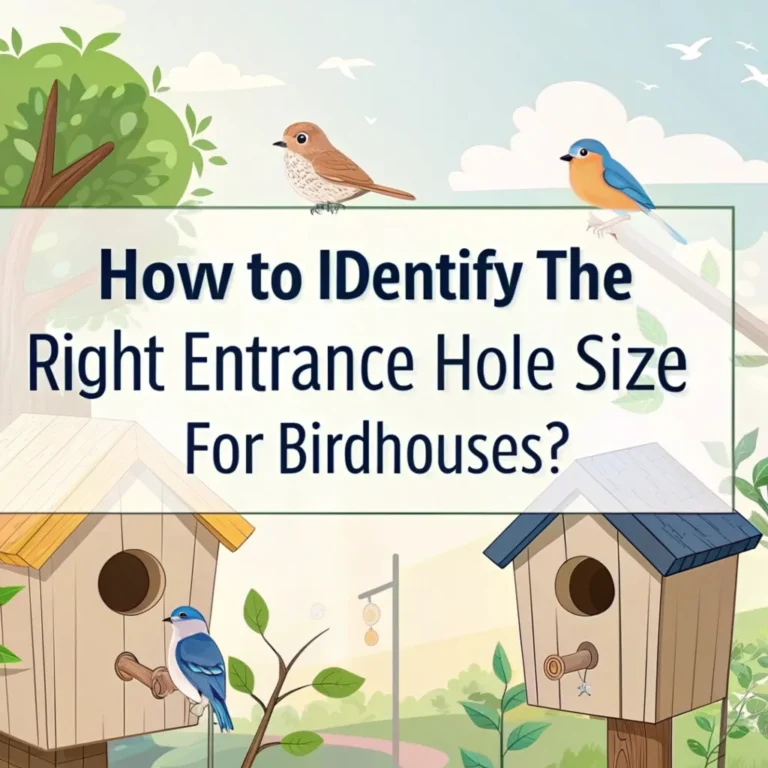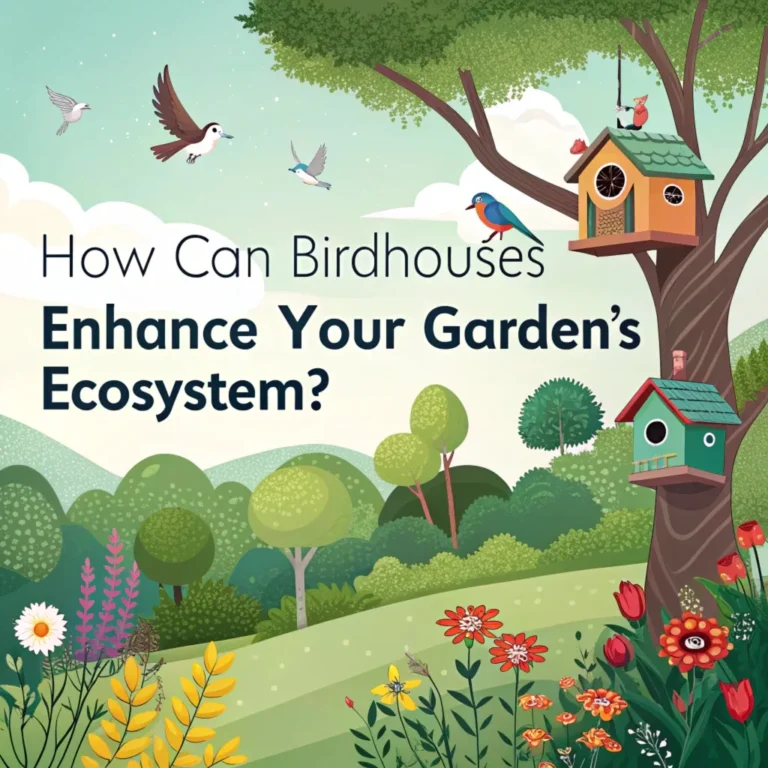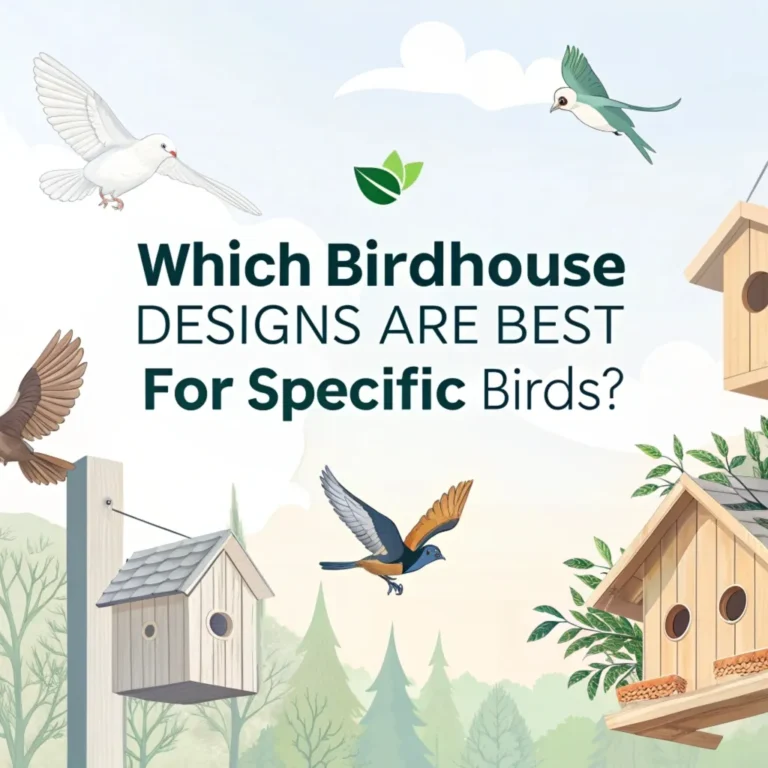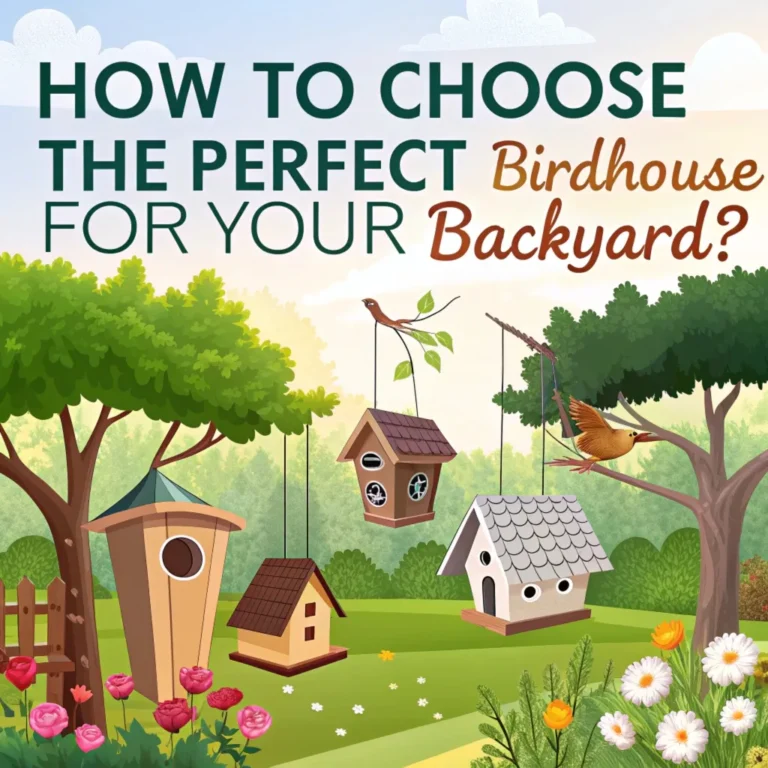How Do You Correctly Position a Birdhouse for Maximum Use?
Placing a birdhouse correctly is essential for attracting birds to your garden. This guide offers practical tips for positioning birdhouses to maximize their use.
By following these suggestions, you can create a safe and inviting space for birds to nest in your yard.
The guide covers key aspects of birdhouse placement. These include choosing the right location, determining the proper height, and considering species-specific needs.
It also addresses important factors like protection from predators and weather elements.

Key Takeaways
- Face birdhouses away from prevailing winds to protect birds from harsh weather
- Mount birdhouses at least 5 feet above ground to keep them safe from predators
- Provide adequate distance between birdhouses to prevent territorial conflicts
- Ensure a clear flight path to the entrance hole for easy access
- Place birdhouses away from feeders and baths to maintain privacy for nesting birds
- Consider species-specific preferences when choosing birdhouse locations
- Offer some shade protection from intense afternoon sun
- Use secure mounting methods to withstand strong winds and storms
- Clean birdhouses regularly to maintain a healthy environment for birds
- Be patient as it may take time for birds to discover and adopt new birdhouses
Optimal Birdhouse Orientation
The direction a birdhouse faces plays a significant role in its attractiveness to birds. Position the entrance hole away from prevailing winds to protect nesting birds from harsh weather conditions.
In many areas, this means facing the birdhouse east or southeast. This orientation also allows morning sunlight to warm the nest, benefiting both adults and chicks.
Proper orientation is essential for creating a comfortable microclimate within the birdhouse. A well-oriented birdhouse provides protection from rain and strong winds, while still allowing for adequate ventilation.
This balance is crucial for maintaining optimal temperature and humidity levels inside the nesting space, which directly impacts the health and survival of both eggs and hatchlings.
Consider the local climate patterns when determining the best orientation for your birdhouse. In areas with hot summers, a slightly north-facing direction might be preferable to prevent overheating during the peak breeding season.
Ideal Height for Birdhouse Placement
Mount birdhouses at least 5 feet above the ground to ensure safety from ground-based predators. Some species prefer higher elevations, so consider the following guidelines:
- Wrens and chickadees: 5-10 feet
- Bluebirds: 5-10 feet
- Purple martins: 10-15 feet
Remember, never exceed a height you can safely reach for maintenance and cleaning purposes.
The height of a birdhouse plays a crucial role in attracting specific bird species and protecting them from predators. Different bird species have evolved to nest at various heights based on their natural habitats and survival strategies.
By mimicking these preferences in your birdhouse placement, you can significantly increase the chances of attracting your target species.
Safety considerations should always be a priority when deciding on birdhouse height. While higher placements may offer better protection from some predators, they can also make maintenance and monitoring more challenging for you.
Spacing Between Birdhouses

Different bird species have varying territorial needs. Provide adequate distance between birdhouses to prevent conflicts:
- For most small birds: At least 25-30 feet apart
- For bluebirds: 100-300 feet apart
- For purple martins: Can be grouped together in colonies
Proper spacing between birdhouses is crucial for maintaining a harmonious bird community in your garden.
Territorial disputes can lead to stress and reduced nesting success, so it’s important to respect the natural spacing preferences of different bird species. This consideration is especially important for birds that are known to be territorial during the breeding season.
By providing appropriate distances between nesting sites, you create a more diverse and balanced bird population in your yard. This spacing not only reduces conflict but also helps distribute the birds’ impact on local insect populations, contributing to a healthier ecosystem overall.
Clear Flight Path
Ensure a clear flight path to the entrance hole. Remove any obstructions like branches or foliage that might impede birds’ access to the birdhouse. A clear path allows birds to quickly enter and exit the nest, which is crucial for their safety and convenience.
A well-designed flight path is essential for the birds’ safety and efficiency. Birds need to approach their nests quickly and directly, especially when carrying food for their young or evading predators.
Obstructions near the entrance can make the birdhouse less attractive to potential nesters and may even lead to abandonment of an active nest.
Regular maintenance of the area around the birdhouse is important. Trim back any new growth that may encroach on the flight path over time, ensuring continued easy access for the birds throughout the nesting season.
Distance from Feeders and Baths
Place birdhouses at least 10-20 feet away from bird feeders and baths. Nesting birds prefer privacy and separation from busy feeding areas. This distance helps reduce stress and potential conflicts with other birds visiting feeders.
The separation of nesting and feeding areas is crucial for several reasons. Nesting birds often become more territorial and may feel threatened by the constant activity around feeders.
Additionally, the concentration of birds at feeding stations can attract predators, potentially putting nesting birds and their offspring at risk.
This distance also helps maintain cleanliness around the nesting site. Feeders can create mess from dropped seeds and increased bird droppings, which could lead to unsanitary conditions near the birdhouse if placed too close together.
Species-Specific Considerations
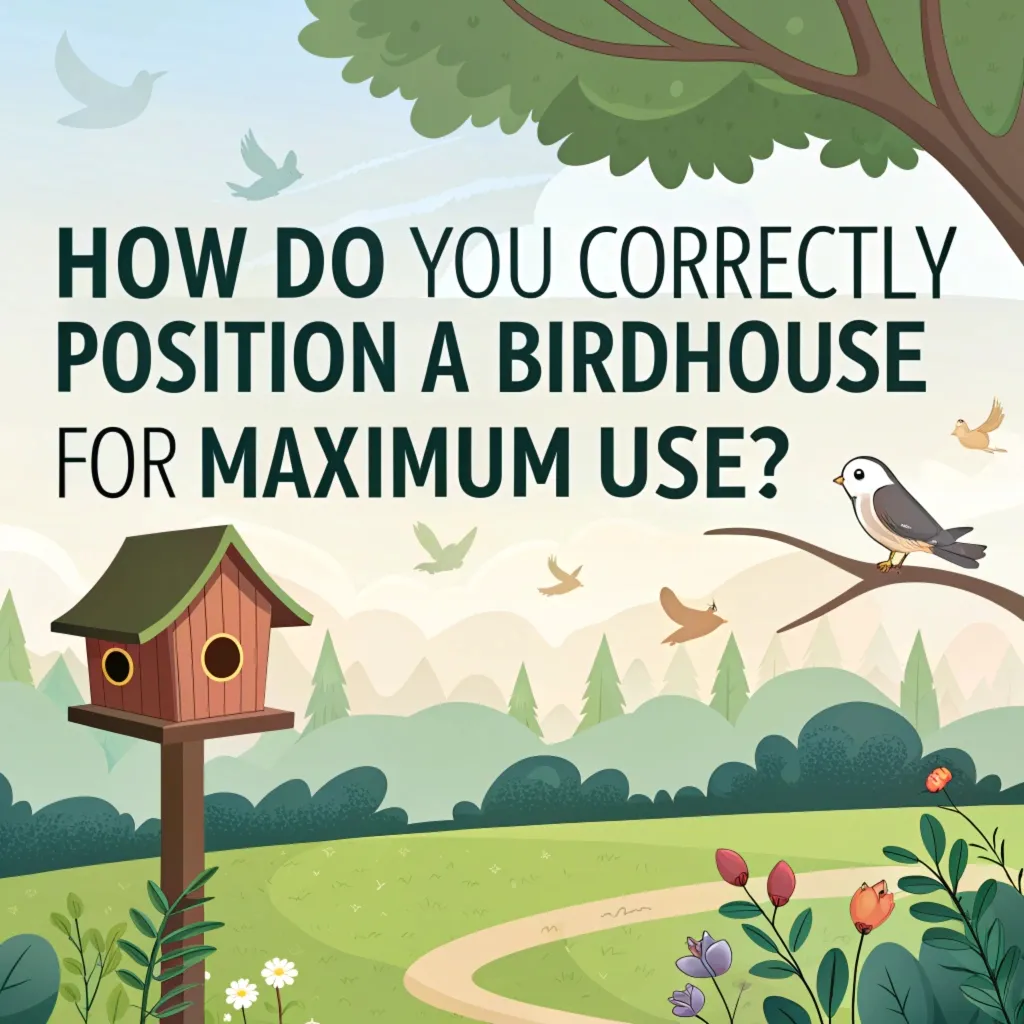
Different bird species have unique preferences for nesting sites:
- Bluebirds: Prefer open areas with low grass
- Wrens: Like areas near bushes or shrubs
- Chickadees: Favor wooded areas or forest edges
- Purple martins: Thrive in open spaces near water
Research the specific needs of birds in your area to optimize birdhouse placement.
Understanding species-specific preferences is key to successfully attracting and supporting nesting birds. Each species has evolved to thrive in particular habitats, and replicating these conditions in your yard can significantly increase the likelihood of birds choosing your birdhouses.
For example, bluebirds prefer open spaces where they can easily spot insects on the ground, while wrens feel more secure with some nearby cover.
Consider the natural behaviors and habitat preferences of the birds you wish to attract. This might involve researching native plant species that provide suitable cover or food sources, or modifying your landscaping to create micro-habitats that appeal to different bird species.
Shade and Protection
While some morning sun is beneficial, excessive heat can be harmful to nesting birds. Position birdhouses to provide some shade during the hottest part of the day. This can be achieved by placing them:
- Under the eaves of buildings
- Near deciduous trees that offer leafy cover in summer
- On the north or east side of structures
Balancing sun exposure and shade is crucial for maintaining a comfortable temperature inside the birdhouse.
Overheating can be fatal to eggs and nestlings, while too little sun can lead to dampness and mold growth. The ideal placement provides warmth in the morning and protection from intense afternoon heat.
Consider the changing seasons when positioning birdhouses. A spot that offers perfect shade in spring might become too exposed as the sun’s path changes in summer. Regularly monitor the birdhouses and be prepared to make adjustments if necessary.
Secure Mounting
Use sturdy mounting methods to ensure birdhouses remain stable in various weather conditions:
- For trees: Use flexible wire or adjustable straps
- For poles: Install baffles to deter climbing predators
- For buildings: Use strong screws or brackets
A secure mount prevents the birdhouse from swaying or falling during storms or high winds.
Proper mounting is essential for the safety of nesting birds and the longevity of your birdhouse. A securely mounted birdhouse provides a stable environment for eggs and nestlings, reducing the risk of accidents or abandonment due to excessive movement.
It also helps protect the birdhouse from damage caused by strong winds or curious predators.
When mounting birdhouses, consider the growth of trees or changes in the surrounding environment. Regularly check and adjust mountings to ensure they remain secure over time, especially after severe weather events.
Regular Maintenance
Clean birdhouses after each nesting season to maintain a healthy environment for future occupants. Remove old nesting material and debris, and wash the interior with a mild soap solution. This practice helps prevent the spread of parasites and diseases.
Consistent maintenance is crucial for the long-term success of your birdhouses. Regular cleaning not only ensures a hygienic environment for nesting birds but also allows you to inspect the birdhouse for any damage or wear that may need addressing.
Proper cleaning techniques include using environmentally friendly cleaning solutions and allowing the birdhouse to dry completely before the next nesting season.
Consider keeping a maintenance log for each birdhouse, noting cleaning dates, any repairs made, and observations about nesting activity. This information can be valuable for understanding patterns of use and improving your birdhouse management over time.
Patience is Key
After placing a birdhouse, be patient. It may take time for birds to discover and adopt new nesting sites. Sometimes, it can take a full season or more before birds start using a new birdhouse. Continue to maintain the birdhouse and surrounding area to increase its attractiveness over time.
Attracting birds to a new birdhouse is often a gradual process. Birds need time to discover the new nesting option and assess its suitability.
During this waiting period, focus on creating an inviting environment around the birdhouse by maintaining native plants, providing water sources, and ensuring a consistent food supply through natural or supplemental means.
Use this time to observe and learn about the birds in your area. Keep a journal of bird sightings and behaviors, which can help you make informed decisions about future birdhouse placements or modifications to your current setup.
Protecting from Predators
Implement measures to protect nesting birds from common predators:
- Install predator guards on poles or tree trunks
- Avoid placing birdhouses near surfaces that cats or other predators can easily climb
- Use entrance holes of appropriate size for target species to prevent larger birds from invading
Effective predator protection is crucial for the success of nesting birds. Predator guards, such as metal baffles or cones, can significantly reduce the risk of nest raids by climbing predators like raccoons or snakes.
The design and placement of these guards should be carefully considered to ensure they don’t inadvertently provide a foothold for predators.
Consider the entire habitat when implementing predator protection measures. Removing nearby branches or structures that could provide access to predators can be as important as the guards themselves. Regular monitoring can help identify and address any new predator threats that may emerge over time.
Monitoring and Observation
Regularly observe birdhouse activity from a distance to ensure everything is going well. Look for signs of occupancy, such as birds carrying nesting material or food. If you notice any issues, such as pest infestations or predator attempts, take appropriate action to address them promptly.
Careful monitoring provides valuable insights into the success of your birdhouse placement and can help you make informed decisions about future improvements.
Use binoculars or a spotting scope to observe from a distance, minimizing disturbance to nesting birds. Keep a log of your observations, noting species, nesting dates, and any unusual activities.
Consider participating in citizen science projects that collect data on nesting birds. Your observations can contribute to broader scientific understanding and conservation efforts for various bird species.
FAQs
How often should I clean my birdhouse?
Clean birdhouses at least once a year, preferably after each nesting season. This practice helps maintain a healthy environment for future occupants.
Can I place a birdhouse in direct sunlight?
While some morning sun is beneficial, avoid placing birdhouses in direct sunlight throughout the day. Excessive heat can be harmful to nesting birds and their young.
What is the best material for a birdhouse?
Wood is the preferred material for birdhouses. It provides good insulation and mimics natural nesting cavities. Avoid metal or plastic, as they can overheat in summer and become too cold in winter.
How can I attract specific bird species to my birdhouse?
Research the preferred habitat and nesting requirements of the species you want to attract. Tailor the birdhouse design, placement, and surrounding environment to match their needs.
Is it necessary to provide nesting material in the birdhouse?
Generally, birds prefer to gather their own nesting material. However, you can place small piles of suitable materials like twigs, grass, and pet hair near the birdhouse for birds to use.

Luna is the passionate founder and author of Birds and You, a website dedicated to sharing her love for birds with fellow enthusiasts. Through her engaging articles and guides, she aims to educate and inspire others to explore the fascinating world of birds. When she’s not writing, you can find Luna observing birds in their natural habitats or sharing beautiful bird photography on Pinterest. Join her on this journey to celebrate and protect our feathered friends!



